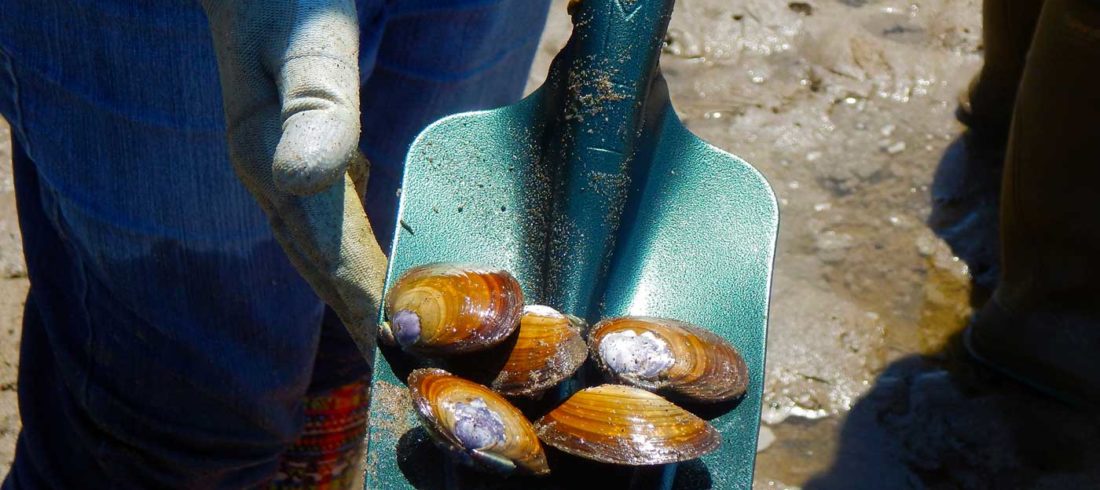Boots scuffle along the wet sand. With a bucket in one hand and a shovel in the other, foragers scan the ground for the little holes alerting them to what’s beneath the surface. Kids race along the beach, spotting holes and digging up the buried treasure, a proud smile shooting across their faces as their parents snap a photo of them holding their prize. Summer activities are endless in Florence, and clamming the Siuslaw estuary is a classic and exhilarating one.
Clamming, surprisingly, doesn’t take many supplies, and can be done by anyone with a little knowledge of what to look for. “People wear anything from knee boots to hip waders, chest waders, or sometimes just old tennis shoes,” says Mitch Vance, shellfish project leader for the Oregon Department of Fish and Wildlife. You can rent a clam gun, bring a shovel, or even use your hands (depending on the type of clams and the sediment they’re living in) to dig. Just be sure to grab a shellfish license for anyone more than 12 years old before you begin your clamming adventure.

Clams make a small hole or dimple in the sand as they burrow and will even shoot water out of the opening if a wave washes over. Another way to test if there’s a clam hiding under the surface is to hit the ground next to the hole with your shovel; if water spurts out, you’re in luck. When using a shovel, make sure to dig 4 to 6 inches away from the dimple so you don’t break the clam’s shell (if you do break a shell, you still have to keep the clam to comply with clamming regulations). Instead of using a scooping motion to dig, stick the head of the shovel straight down and lift sand out, moving closer to the dimple with each dig. If you’re using a clam gun, center it on the dimple and slowly press down. After you grab the clam, refill the hole.
Razor clams are very speedy diggers, so once you find their home, make sure you dig fast. Most clams live about 1 to 3 feet below the surface. Currently, razor clamming in Florence is closed due to elevated levels of domoic acid, but bay clams are still good to dig. Always call the shellfish hotline (800/448-2474) before you go to make sure there are no health advisories.
Purple varnish and eastern softshell clams are the two most abundant varieties in Florence, Vance says. Purple varnish clams got their name from the intense coloring on the inside of their shells.
“Summer is a great time to go clamming in Florence,” Vance says. “Good access to intertidal clam flats, and the fact that these species can be found at tide levels above zero, allows for many opportunities.” The best time to clam is at peak low tide, so make sure you check the tide tables: the lower the tide, the more access you’ll have to dig.
You’ll have the most success visiting the south jetty docks and flats, the north jetty fish ladder, the Florence docks, the North Fork flat, and the Port of Siuslaw boat launch. If you want to try and dig up cockles, gapers, butters, or native littleneck clams, take a short drive to nearby Yaquina Bay or Coos Bay.
Once you’ve gathered all of your clams for the day, it’s time to let them sit before enjoying them. Allow your clams to “purge,” or release any sand, by soaking them in cold seawater or salted tap water for two hours. Then, for small clams, steam until the shells open, clean, and then enjoy. For larger clams, either soak them in warm water and clean, or simply shuck the live clam and clean it. To clean a clam, remove the skin and, for larger ones, any gut contents. Softshell clams and purple varnish clams are great in chowder or simply drizzled in melted butter.
Clamming in Florence is not only an enjoyable family activity, it’s an easy beach getaway with its accessibility and lack of special tools. Grab your shovel, your camera, and your kids to make some memories. Or, grab some much-needed alone time as you walk and dig, or maybe take a date to try something new together. Whatever the reason, grab your shovel and go. You won’t regret it.


